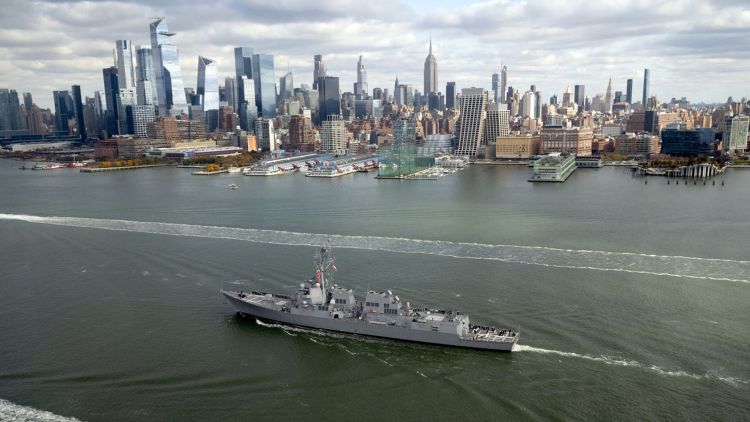The US Navy’s newest warship, the USS John Basilone (DDG-122), is about to join the fleet, and it’s bringing with it a legacy as bold and heroic as its namesake.
This Arleigh Burke-class guided-missile destroyer, as announced last Friday, November 2, is set to be commissioned on November 9 in New York City, adding one more powerful vessel to the Navy’s lineup.
Not only does the USS John Basilone boast impressive technical capabilities, but it’s also a tribute to Gunnery Sgt. John Basilone, one of the most decorated Marines of World War II.
On the other hand, the Navy has announced it will extend the service lives of three Ticonderoga-class cruisers, giving the fleet some much-needed firepower well into the next decade.
Let’s dive into what makes the USS John Basilone unique and how these recent developments add value to the Navy’s surface fleet.
Honoring a Legendary Marine: Gunnery Sgt. John Basilone
John Basilone isn’t just any name. He was a Marine’s Marine, a legendary Gunnery Sergeant who earned both the Medal of Honor and the Navy Cross during WWII—a rare and honorable distinction.
Known for his bravery at Guadalcanal and his final stand at Iwo Jima, Basilone embodied the kind of courage and tenacity that makes for a legendary figure.
His actions at Guadalcanal, where he single-handedly kept machine guns firing under constant enemy pressure and repeatedly risked his life to resupply his unit, earned him the Medal of Honor.
The US Navy’s newest warship, the USS John Basilone (DDG-122), is about to join the fleet, and it’s bringing with it a legacy as bold and heroic as its namesake.
This Arleigh Burke-class guided-missile destroyer, as announced last Friday, November 2, is set to be commissioned on November 9 in New York City, adding one more powerful vessel to the Navy’s lineup.
Not only does the USS John Basilone boast impressive technical capabilities, but it’s also a tribute to Gunnery Sgt. John Basilone, one of the most decorated Marines of World War II.
On the other hand, the Navy has announced it will extend the service lives of three Ticonderoga-class cruisers, giving the fleet some much-needed firepower well into the next decade.
Let’s dive into what makes the USS John Basilone unique and how these recent developments add value to the Navy’s surface fleet.
Honoring a Legendary Marine: Gunnery Sgt. John Basilone
John Basilone isn’t just any name. He was a Marine’s Marine, a legendary Gunnery Sergeant who earned both the Medal of Honor and the Navy Cross during WWII—a rare and honorable distinction.
Known for his bravery at Guadalcanal and his final stand at Iwo Jima, Basilone embodied the kind of courage and tenacity that makes for a legendary figure.
His actions at Guadalcanal, where he single-handedly kept machine guns firing under constant enemy pressure and repeatedly risked his life to resupply his unit, earned him the Medal of Honor.
When he returned stateside to help with the war bond effort, Basilone didn’t opt for a safer path. He voluntarily returned to combat, losing his life at Iwo Jima, where he again showed outstanding courage that posthumously earned him the Navy Cross.
The USS John Basilone is actually the second ship named after this heroic Marine; the first was a Gearing-class destroyer decommissioned in 1977.
Now, this new destroyer is ready to honor his legacy with its own form of service and protection.
What Makes the USS John Basilone Stand Out?
The USS John Basilone is part of the Navy’s Arleigh Burke-class destroyers, a class known for versatility and advanced technology.
These ships are fitted with the Aegis Combat System, a sophisticated defense platform capable of tracking and neutralizing enemy aircraft, ships, and missiles.
The USS John Basilone also has advanced SPY-1D radar and can launch Tomahawk missiles, SM-2 missiles, and Evolved Sea Sparrow Missiles, making it a powerful and adaptable warship for both offensive and defensive operations.
A unique feature of the USS John Basilone is its battle flag, which carries symbols directly connected to Basilone’s life and service.
The flag includes a pair of crossed Browning M1917 machine guns—paying homage to his role as a machine gunner at Guadalcanal—along with a blue diamond and stars in the shape of the Southern Cross.
The design incorporates golden palm branches, a nod to the Guadalcanal terrain where he made his stand, and the mottoes “Take a Stand” and “Move Forward,” which capture the indomitable spirit Basilone exemplified throughout his life.

Once commissioned, the ship will head to its homeport at Naval Station Mayport, Florida, where it will continue the tradition of service its namesake so heroically embodied.
Extending the Service Lives of the Ticonderoga-Class Cruisers
In a related move to keep the Navy’s capabilities sharp, the service announced Monday it would extend the lives of three Ticonderoga-class guided-missile cruisers: the USS Cape St. George (CG-71), USS Gettysburg (CG-64), and USS Chosin (CG-65).
This announcement comes less than a week after a similar decision to extend the service of 12 Arleigh Burke-class destroyers between 2028 to 2035.
Originally set for retirement, the Ticonderoga-class cruisers will now stay in the fleet until 2029. This decision adds a total of 10 years to their combined service lives, ensuring these valuable assets remain operational as newer ships enter the fleet.
The Ticonderoga-class cruisers are known for their formidable firepower and versatility. Equipped with the Aegis Combat System, they excel in anti-air, anti-surface, and anti-submarine warfare, making them a central force in any carrier strike group.
These cruisers were part of a modernization program that upgraded their hulls, mechanical systems, and engineering equipment to extend their service life, giving them a fresh capability boost.

The Gettysburg and Chosin have already completed these upgrades, with the Cape St. George scheduled to finish by the end of this year.
Currently, Gettysburg is deployed with the Harry S. Truman Carrier Strike Group, while Chosin is preparing for future deployment.
Extending the service lives of these three cruisers makes strategic sense. The Navy initially aimed to keep 11 of its 22 Ticonderoga-class cruisers active into the 2030s. However, setbacks in the modernization program led to budget constraints and delays, forcing the Navy to retire most of the class.
With the recent decommissioning of the USS Vicksburg and USS Cowpens, these three cruisers are now among the last of their class.
Why These Moves Matter
The commissioning of the USS John Basilone and the extension of the Ticonderoga-class cruisers’ service lives highlight the Navy’s effort to maintain a powerful and versatile fleet. With global tensions high, having these capable ships ready for deployment is crucial.
The Navy’s decision to keep these cruisers operational aligns with its commitment to advancing US maritime strength while newer ships and classes continue to roll out.



